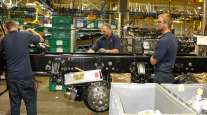More Foreign Competition Seen Hurting North American OEMs
This story appears in the Sept. 27 print edition of Transport Topics.
Low-cost commercial vehicle producers in Russia, India and China are poised to push North American OEMs out of truck markets in emerging nations within four years, according to a study by AlixPartners LLP.
“Despite the recovery and expected growth . . . North American [original equipment manufacturers] are being outflanked both by emerging-market-based OEMs, which now account for two-thirds of global commercial-truck production, and by European competitors, who have gained first-mover advantage vis-à-vis partnerships with low-cost indigenous companies,” the Sept. 3 report stated.
Spokesmen for Daimler Trucks North America and Navistar Inc. strongly disagreed with the report, saying that they have robust and growing sales and production efforts worldwide, including in emerging markets.
Volvo AB, parent company of Volvo Trucks North America and Mack Trucks Inc., did not comment. In a recent report, the Swedish truck maker said its worldwide deliveries — including to Asia, South America, the Middle East and Africa — increased 46% through the first eight months of 2010 from last year.
AlixPartners LLP, Southfield, Mich., describes itself as a global business-advisory firm that employs 900 people in North America, Europe and Asia. It said that by 2014, North American truck makers would have difficulty exporting to any emerging market.
North American OEMs “are not well-positioned to exploit this increasing demand in emerging markets because of a mismatch of product types, a lack of local partners and, especially, too-high costs,” the report said.
“Moreover, producers in China, India and Russia together are expected to boost their output by some 50% over the next four years due to the strength of domestic economies and demand from other emerging markets in Southeast Asia, Africa, the Middle East and Central America,” the report stated.
“Once China and India catch up with Western truck technology, they will pose the threat of not only shutting out North American manufacturers from emerging markets, but will become a threat to their own domestic markets” in North America, Tai Li, an AlixPartners director, told Transport Topics.
“North American companies must invest in producing simpler designs for commercial vehicle components so that they can generate the significant cost improvements — up to 50% — necessary to compete in the future,” the study advised.
DTNA spokeswoman Maria McCullough said that its parent company, Daimler AG, covers nearly every market in the world, and Daimler Trucks North America exports globally.
“Freightliner Trucks is a significant exporter to Central America, and most South American countries, with the exception of Brazil, Venezuela and Argentina, where Mercedes-Benz Trucks has a large market share,” McCullough told TT.
Mercedes-Benz is Daimler’s main truck brand in Europe and in several export markets.
“Freightliner Trucks is also a large exporter to New Zealand, Australia and South Africa,” McCullough added.
She said that DTNA’s Western Star Trucks is a big exporter to Africa, Australia and Indonesia.
Daimler AG’s Mitsubishi Fuso truck company, based in Japan, exports both to Asia and to most of Africa, McCullough said.
“Daimler also has several joint ventures globally, including Russia,” she said.
Daimler’s Mitsubishi Fuso and Mercedes-Benz have separate joint venture partnerships with Russian truck maker Kamaz, while Daimler AG itself owns an 11% equity interest in Kamaz, “which covers Daimler in Russia,” she said.
“Freightliner Trucks possibly has the largest share of non-European vehicles on the Russian highways today, as well as an extensive service network with more than a dozen service outlets along the Trans-Siberian Highway,” McCullough said.
She said that in India, Daimler AG has a wholly-owned subsidiary that exports throughout South Asia. In China, Daimler AG has a joint venture with Beiqi Foton Motor Co.
“With Daimler’s global engine platform, we have the capability to build to and meet all emissions standards in every plant around the world, including both Euro and EPA requirements,” McCullough said.
AlixPartners “must be talking about some other company, because we’re doing well overseas,” Navistar spokesman Roy Wiley told TT.
“Our joint venture with Mahindra Group, one of India’s largest vehicle manufacturers, has already led to the release of our first joint-designed heavy-duty truck this year in that country,” he said. Once the joint venture products are established in India, the companies plan to export them worldwide.
“We also signed an accord with Caterpillar two years ago to explore joint truck and engine ventures around the world,” Wiley added.
Navistar announced one result of that venture on Sept. 16, saying that the joint venture signed an accord with the Chinese company Anhui Jianghuai Automobile Co. Ltd. — also known as JAC — “to develop, build and market advanced commercial vehicles in China.”
The Navistar-Caterpillar venture also agreed with JAC to develop and build advanced diesel engines in China, Navistar said. The deal is pending approval by the Chinese government.
“The truck and engine agreements are integrated to support the advanced technology power requirements of a number of medium- and heavy-duty vehicles, which include the JAC Sword and Gallop brands and International Brand TranStar, positioning JAC products in China to meet the ever increasing demands of the Chinese market,” Navistar said.
Paccar Inc., which owns Peterbilt Motors and Kenworth Truck Co., as well as DAF Trucks in Europe, did not respond to requests for comment.



